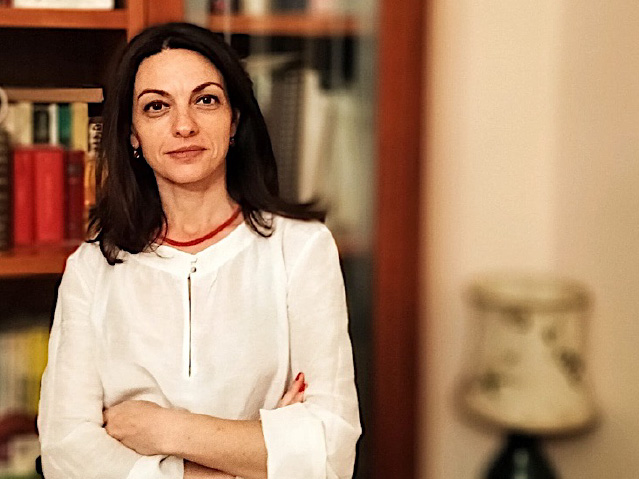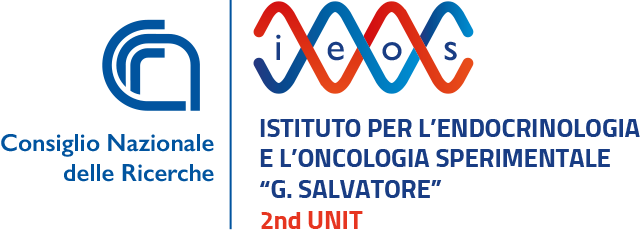Giovanna Grimaldi

Current Position:
Senior Researcher
Cell Regulation LAB
Contacts:
Phone: +39 0816132578
Lab: +39 0816132495
Email: g.grimaldi@ieos.cnr.it
giovanna-grimaldi@cnr.it
Keywords:
MARylation, PARP12, cancer, viral infection, intracellular transport, cell signalingI have always been fascinated in understanding how cells operate and how the different signalling pathways are coordinated, specifically by post-translational modifications. Within the different regulation layers, my research studies aim to investigate the role played by mono-ADP-ribosylation (MARylation), via a successful pipeline that combines advanced cell-based imaging, biochemistry, proteomic and bioinformatic approaches.
In this field, my work has uncovered for the first time the roles of PARP12-mediated MARylation during exocytosis of basolateral cargoes and endocytosis, under physiological and stress conditions. In this latter context, MARylation has been demonstrated to play significant roles in the host anti-viral response with PARP12 - one of the enzymes catalyzing this reaction- having a prominent role during viral replication. Based on my consolidated, decennial experience in the study of cell signalling pathways, I am now focusing on the role played by MARylation during viral entry as well as on the identification of cellular and viral targets controlled by this post-translational modification. The final objective of this research project is the identification of key molecular constituents and mechanisms that regulate viral induced cytopathogenicity, host-cell alterations and response to infection, with the overall goal of finding ways to limit virus infection and/or reduce the severity of the virus-associated disease.
Activation of stress response pathways is also common to cancer cells. This represents an additional area of investigation within my research interests, specifically focusing on the role played by MARylating enzymes in guaranteeing cell survival and proliferation, functions that are often altered in cancer cells.
I firmly believe that the identification of key functions controlled by MARylating PARPs and the development of specific inhibitors will likely have a general impact on cell biology research, with even more important potential applications for the treatment of multiple diseases.
Education
2012: PhD in Life Sciences
Project: Identification and roles of intracellular substrates of mono-ADP-ribosylation.
2006: Masters in Medical Biotechnology (summa cum laude), University of Florence.
Thesis: Role of the tyrosine kinase FAK in the repulsive response mediated by ephrinA1.
2004: Degree in Biotechnology (summa cum laude), University of Florence.
Thesis: Interaction between the Eph receptor and the low molecular weight tyrosine phosphatase LMW-PTP. Effects on the repulsive response.
Positions
From Gen 2023-Present: Senior Researcher
From Dec 2018- Dec 2022: Permanent position as Researcher at the National Research Council (CNR, Naples);
From Jun 2014 to Nov 2019: Fixed-term contract as researcher at the CNR Institute of Protein Biochemistry (Naples);
From Jan 2012 to May 2014: Post-doc position at the CNR Institute of Protein Biochemistry (Naples);
From Jan 2009 to Dec 2011: Fellowship from the Italian Federation for Cancer Research;
From Apr 2007 to Dec 2008: Doctoral Fellowship, Department of Cell Biology and Oncology, Consorzio Mario Negri Sud;
From Sept 2006 to March 2007: co-co-co contract at the University of Florence, Department of clinical Physiology.
Sector: Biomedical research
- Pavithran A, Morone B, Filograna A, Matarese M, Lo Monte M, Dathan NA, Corda D, Grimaldi G. PARP12-mediated ADP-ribosylation contributes to breast cancer cell fate by regulating Akt activation and DNA-damage response. Cell Mol Life Sci. 2025 Jan 23;82(1):58. doi: 10.1007/s00018-025-05586-z.
- Morone B, Grimaldi G. PARP enzymes and mono-ADP-ribosylation: advancing the connection from interferon-signalling to cancer biology. Expert Rev Mol Med. 2024 Aug 27;26:e17. doi: 10.1017/erm.2024.13.
- Di Paola S, Matarese M, Barretta ML, Dathan N, Colanzi A, Corda D, Grimaldi G. PARP10 Mediates Mono-ADP-Ribosylation of Aurora-A Regulating G2/M Transition of the Cell Cycle. Cancers (Basel), 2022, 14(21):5210. doi: 10.3390/cancers14215210
- Grimaldi G, Filograna A, Schembri L, Lo Monte M, Di Martino R, Pirozzi M, Spano D, Beccari AR, Parashuraman S, Luini A, Valente C, Corda D. PKD-dependent PARP12-catalyzed mono-ADP ribosylation of Golgin-97 is required for E-cadherin transport from Golgi to plasma membrane. Proc Natl Acad Sci U S A. 2022; 119(1).
- Grimaldi G, Catara G, Palazzo L, Corteggio A, Valente C, Corda D. PARPs and PAR as novel pharmacological targets for the treatment of stress granule-associated disorders. Biochem Pharmacology. 2019; 167: 64-75.
- Grimaldi G and Corda D. ADP-ribosylation and intracellular traffic: an emerging role for PARP enzymes. Biochem Soc Trans. 2019 Feb 28;47(1):357-370.
- Catara G*, Grimaldi G*, Schembri L, Spano D, Turacchio G, Lo Monte M, Beccari AR, Valente C, Corda D. PARP1-produced poly-ADP-ribose causes the PARP12 translocation to stress granules and impairment of Golgi complex functions. Sci Rep. 2017 Oct 25;7(1):14035. *These authors contributed equally to this work.
- Colanzi A*, Grimaldi G*, Catara G, Valente C, Cericola C, Liberali P, Ronci M, Lalioti VS, Bruno A, Beccari A, Urbani A, DeFlora A, Nardini M, BolognesiM, Luini A, Corda D. Molecular mechanism and functional role of brefeldin-A-mediated ADP-ribosylation of CtBP1/BARS. Proc Natl Acad Sci U S A. 2013; 110(24): 9794-9. *These authors contributed equally to this work.
Jul 2023 – Present: Principal Investigator of the project “Overcoming Breast Cancer Resistance to Hormone-Based Therapy by Targeting the PARP12 Enzyme,” funded by the Italian Association for Cancer Research (AIRC). SIS IG_28688, 5-year grant (Jul 2023 – Jun 2028).
Nov 2022 – Present: Head of the Research Unit and CNR Representative for Spoke 1-affiliated Institutes within the PNRR project “One Health Basic and Translational Research Actions Addressing Unmet Needs on Emerging Infectious Diseases,” funded by the European Community. This is a 3-year multicenter project (Nov 2022 – Oct 2025).
Jun 2018 – Oct 2024: Co-coordinator of the Second Unit: Progetto Ricerca Finalizzata (under 40) from Ministry of Health GR-2018-12367517_Pharmacological targeting of CtBP1/BARS in cancer.
Scientific Coordinator of the following projects (Departmental Funds):
Jul 2022-present: Scientfic Coordinator of the project: “PARP12-dependent mono-ADP-ribosylation controls specific membrane transport routes: a functional and morphological analysis.” (DSB.AD001.242; Prot. IEOS: 3225/2022; 3226/2022).
Jun 2022-present: Scientfic Coordinator of the project “Mechanisms of the Enhanced Inflammatory Responses in Ageing Individuals: INFLAMMAGEING.” (DSB.AD001.239; Prot. 2531/2022; 2532/2022).
Invited Speaker at the AIRC event “AIRC’s Strength in the Territory: The Impact on Cancer Treatment” (June 3, 2024, Teatro Comunale Gerardo Guerrieri, Matera) as a researcher selected for the AIRC SIS grant, in recognition of scientific excellence. Among the other speakers: Andrea Sironi (President of the AIRC Foundation), Federico Caligaris Cappio (Scientific Director of the AIRC Foundation), and Alberto Mantovani (Scientific Director of Humanitas, Emeritus Professor at Humanitas University, and President of the Humanitas Research Foundation).
Invited Speaker at a TED Talk (2024) – Recognition for contributions to scientific dissemination and innovation in the field of biomedicine, with a particular focus on cancer research. (https://www.facebook.com/photo.php?fbid=914144320863155&id=100068027855471&set=a.511532657790992).
Comunicato stampa CNR. https://www.cnr.it/it/comunicato-stampa/10839/cosi-le-cellule-perdono-i-contatti;
https://www.italiasalute.it/news2H.asp?ID=14563;
https://www.medicinaintegratanews.it/e-caderina-manca-il-contatto-ed-e-patologia/
https://www.italpress.com/unalterazione-causa-la-perdita-dei-contatti-tra-cellule/
https://www.facebook.com/search/top?q=fondazione%20incontra%20donna%20potenza
https://www.cnr.it/it/comunicato-stampa/10839/cosi-le-cellule-perdono-i-contatti
https://www.italiasalute.it/news2H.asp?ID=14563
https://www.medicinaintegratanews.it/e-caderina-manca-il-contatto-ed-e-patologia/
https://www.italpress.com/unalterazione-causa-la-perdita-dei-contatti-tra-cellule/



